silicone/mastic around floor
I've recently had a new floor laid over underfloor heating. It's a good quality white oiled oak. however the installers have sealed it with a really ugly white silicone. Will that come up easily without damaging the floor?
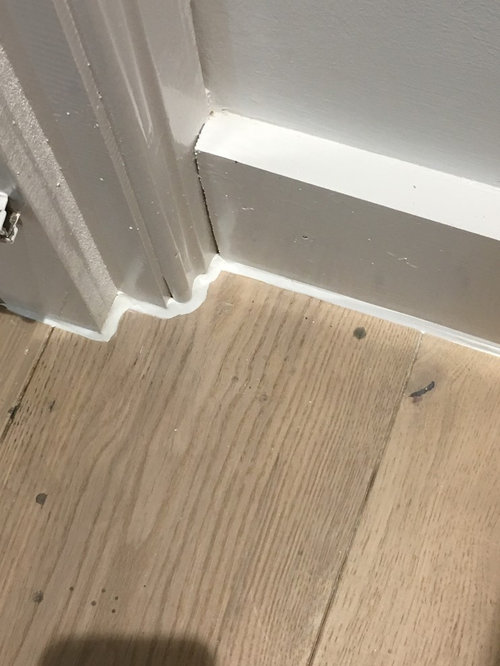
Comments (44)
E D
4 years agolast modified: 4 years agoI’m not an expert but I’m pretty sure with some care it would be possible to lift the silicone without damaging the floor.
You may want to research if and how long you need to let it dry before doing this.
The alternative may be to have some quadrant or other beading along the skirting. Or were you considering that already?
Claudia Cooper thanked E DPatrina
4 years agoHow sad about that awful silicone :-( This is the first time I've ever seen wood floor being finished like that. Keeping my fingers crossed E D's suggestion works.
Claudia Cooper thanked PatrinaClaudia Cooper
Original Author4 years agoThanks both. I expressly said I didn't want beading - so I'll be angry if that's what i end up having to get to cover it
Juliet Docherty
4 years agoI would flip if someone did that. I don't understand how you can be in the business of fitting lovely flooring to then go and slap white silicone around the edges. To remove it will be a real faff and a messy job, so do you trust them to even do that properly? You can remove it with WD -40 check it out on YouTube. You would have to protect the floor up to the sealant, perhaps with tape because whatever you remove it with could damage the finish on the floor. You can get special wood coloured sealants for this purpose, matching the gap to a wood colour is better that the skirting colour, it just draws the eye. Hope you get this sorted.
Claudia Cooper thanked Juliet DochertyClaudia Cooper
Original Author4 years agoThank you colourhappy....I think I would prefer a slightly damaged floor to this
Juliet Docherty
4 years agoMe too, I couldn't live with it. I have removed silicone myself and it is possible, just a bit fiddly. Last year a tiler fitted a huge amount of tiling for us and then rushed the grouting and used too much water to clean it up, resulting in cloudy, whitish patchy grout that looked dreadful. I bought about six bottles of grout sealant and managed to mix an exact colour match and painstakingly applied it to every grout line over two days. It now looks great. The tiler would never have done this so I had to fix it myself, however, it was worth the pain as it would have bugged me so much. Good luck.
Claudia Cooper thanked Juliet DochertyBow Sward
4 years agoBelieve there is a silicone remover product available. Also, a clear silicone product to replace that white mess they have left you with, unless the space left after white silicone is removed is too wide, in which case wood beading in various profiles/depths may be suitable to cover the gap tidily
Claudia Cooper thanked Bow SwardMonica
4 years agoBow Sward is correct, there is a product called silicone remover which will soften the dried up silicone for easy removal. BUT like Colourhappy pointed out, the products will most likely stain the existing flooring maybe irreversibly as these products have silicone and other solvents that will soak into the beautiful board around the perimeter.
It's shocking that someone thought that was a good way to finish a beautiful flooring, I truly hope they manage to rectify it for you.
Claudia Cooper thanked MonicaDaisy England
4 years agoOh dear, that’s dreadful. I wouldn’t be happy with that. What an eyesore. Couldn’t they have removed the skirting, run and floor right up to the walls and put the skirting back on?
Claudia Cooper
Original Author4 years agoThat particular area is part of a new extension, so they put the skirting on it wasn't previously existing. So I am hoping they laid the floor and put the skirting on top, currently it's hard to tell
Juliet Docherty
4 years agoIf they had put the skirting on top, surely they wouldn't have needed to use silicone. I would get a scalpel or stanley knife and cut a bit away to find out.
Plush Interiors
4 years agoI hope you get this sorted. your fitter should not have finish like this. im not sure what you could use without damaging your flooring. I know there are coloured sealants they could of used. I hope you get it sorted
Claudia Cooper thanked Plush InteriorsE D
4 years agoI actually think they shouldn't have used ANY silicone.
It's hard to judge from the one photo, but it also looks the skirting (and perhaps other woodwork) hasn't been fixed to a good standard. There are gaps that could easily have been filled (but NOT with silicone).Claudia Cooper
Original Author4 years agoWell he's been round and has said that you have to use a mastic otherwise there will be gaps, and that you have to leave gaps for expansion
E D
4 years agolast modified: 4 years agoYes, you do have to leave gaps for the timber to be able to expand but this gap could still be covered up by skirting.
Claudia Cooper thanked E DClaudia Cooper
Original Author4 years agothat's what I thought - the expansion gap is between the plank and the wall isn't it? Not the top of the plank and the bottom of the skirting?
Sonia
4 years agoJust stayed in a lovely Victorian holiday let last week and I did notice the bathroom wooden floor was finished the same as yours with white mastic. Looked awful but I suppose the only way to finish it well is to remove the skirting before laying the wooden floor, and in a period house that can be difficult and may mean damaged skirting. I’m not sure what can be done.
Claudia Cooper thanked SoniaClaudia Cooper
Original Author4 years agoI've had underfoor heating installed, so there's a sub floor so it shouldn't be that hard to get it all straight and level with well-fitted skirtings. Sigh!
Daisy England
4 years agoIt’s not the end of the world if the skirting is damaged. Just find a Joinery company who can make you some more. We do it. Even if we have to buy new cutters for the machine and take a sample of the skirting to the cutter manufacturers. It’s definitely doable.
Claudia Cooper thanked Daisy EnglandItalian Design Ltd
4 years agoIt's a badly done job but this kind of finish is not uncommon. I assume that the skirting board was already there. A good fitter would have offered to cut the skirting board and slide the floor underneath, leaving the required expansion gap which would be invisible as covered by the skirting board. This job would have made the floor looking great but would have costed you a bit more in labour.
What can you do now?
Removing the silicon is not that easy and you may end up damaging the floor. In any case, if you remove the silicone you may end up with a visible gap.
You may install some edging which is just better than silicone ans is the cheaper option.
the best option is to install skirting boards covers. https://www.kentsdirect.com/product/inside/4-no-2-5m-8-x-100mm-skirting-board-cover/ . Hope this helps
 Claudia Cooper thanked Italian Design Ltd
Claudia Cooper thanked Italian Design LtdSonia
4 years agoThat looks like an excellent solution @Italian Design. Didn’t realise such a thing existed!
E D
4 years agoYes those covers may be an option but you will get very ‘thick’ skirting which may be bit of a problem around architraves and door frames I feel.
Luciana
4 years agoHmmm, if I may play the devil's advocate here... We have underfloor heating and silicone around the skirting board everywhere in the house, top to bottom. I admit, I hated it after they had just finished laying it and thought of having it removed. However, the builder told us it helps not only to cover the expansion gap, but also to better insulate the house. And I guess he was right, as this is the least drafty Victorian house I've lived in. But we really have it everywhere, including framing my wonderful Minton tiles, in the bedrooms and even around window sills. (sorry, I don't have close-up pics, but I hope it is easy to see).

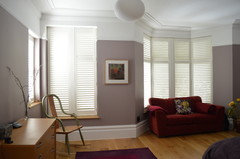
My suggestion is to let it be or invest in those covers. Silicone might not be the most attractive, but it serve a purpose and really helps. Plus, when you have furniture&stuff around, you won't even notice it. I certainly don't, after 7 years of living with it.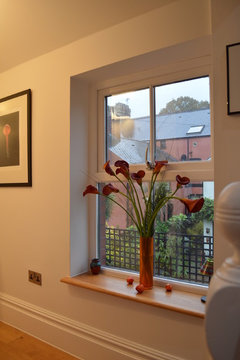 Claudia Cooper thanked Luciana
Claudia Cooper thanked LucianaBrandler London
4 years agoI too am surprised that your floor layers would ever consider using what looks like a white acrylic product.
Firstly, do not even think about using a stanley knife or scalpel as this will damage the floor however careful you are. There is a plastic tool that can be bought from B&Q for example that is specific to the task and is also used by the pros for acrylic/mastic removals.
Depending on the type of acrylic/mastic that has been used it should come up relatively easily as the floor has been oiled and this should prevent penetration into the grain of the wood. Get your floor fitter to do a test area in a spot which is not obvious before proceeding to a complete removal. This is to also make sure that the acrylic has completely cured as otherwise clean removal will be a problem.
If you did not agree this acrylic with your floor fitter then get them to come back to remove it. I am assuming that the floor was a replacement so there will be an issue with expansion if the floor cannot go beneath the existing skirting. On a complete refurbishment a new skirting should have been installed a few mms above the new flooring with no acrylic being used.
If the flooring was installed to the skirting then there will be an expansion gap, however a coloured acrylic should have been used of a similar colour to the floor.
The cover type skirting is an option but again it must be installed a few mm above the floor surface to allow for expansion. I am not sure that this option would work however as there looks like there will be a conflict with the architraves of your doors and this will require a skilled carpenter to deal with this unless the manufacturer has a standard solution.
One observation that I would make is that your photograph shows a pet hate of mine, which is gaps between skirting and architrave and also architrave and wall. This is where a white acrylic should have been used to give a clean crisp finish especially bearing in mind that it can be painted.Claudia Cooper thanked Brandler LondonClaudia Cooper
Original Author4 years agoLuciana, I have to say that I think yours looks an awful lot better than mine. Doesn't it get dirty? Another issue I have is that it means you can never have your skirting boards any colour other than white.
Brandler, thank you for your advice. I've spotted the gap too. It is only in a downstairs loo so not a main living area but, even so, it's poor finishing.Luciana
4 years agoClaudia, I have to say it cleans without problem and doesn't seem to stain. As you can see, the paint on the wood is starting to chip and discolour, but the silicone looks intact. That could be due to the quality of the material used, as from what I can remember, the builder applied some high-grade trade silicone, not the stuff you'd buy at B&Q.
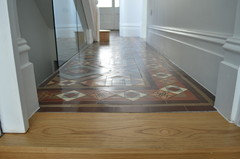
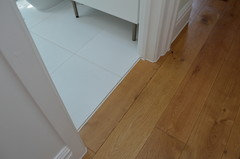
Good luck with whatever you decide, however if you want to get rid of it, ask your builders to do it; they should, in principle, know the best ways to remove it.Claudia Cooper thanked LucianaClaudia Cooper
Original Author4 years agoWell, update on this. I've had a series of people round to advise and all conclude that there is no way of removing the silicone without causing huge damage to the floor. So I'm stuck with it.
Claudia Cooper
Original Author4 years agolast modified: 4 years agoThere isn't one really - unless I rip it up and start again...and if I do that I'll be beating the building contractors to death with it
E D
4 years agolast modified: 4 years agoYou could do that.
Or... use some beading (not beating) after all instead.
Claudia Cooper
Original Author4 years agoI think that will make it look worse unfortunately, I've had two carpenters look at it and both say it won't look great.
E D
4 years agoI must say the silicone in Luciana’s photos looks good.
How does yours look look from a greater distance (than in your photo)?E D
4 years agolast modified: 4 years agoSkirting over wooden flooring looks best but a simple beading can look fine (I think).
These photos are from ours.
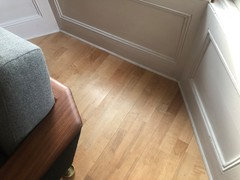
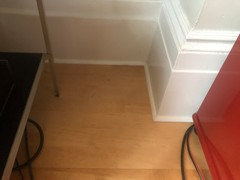 Claudia Cooper thanked E D
Claudia Cooper thanked E DJonathan
4 years agoPersonally I think the silicone has a practical purpose if this is the downstairs wc. There are other colours of silicone that could go over the top if you don’t like white but given your sanitary ware is white and you no doubt have other silicone in the room perhaps in this situation is isn’t too bad.
Claudia Cooper
Original Author4 years agoIt's everywhere - the whole of the downstairs and in huge thick stripes around original Victorian architraves and panelling
Studio O+U Architects
4 years agoI think it has been poorly finished and should have been wiped or rubbed down with a wet cloth before it went off. That way it would not be visible on the surface and be under the skirting board
What surprises me is why one thinks it is required on the front. If its a new skirting profile it should be chamfered on the back edge and the silicone applied to the rear of the board not the face. The compression would seal the gap and any silicone coming through would be wiped or cut away.If it is an existing skirting then there is little choice but to apply it on the front edge, but it should be wiped away from the face as its purpose, if any, is to seal the gap between the floor and the skirting
If one looks back to Victorian and Edwardian times they managed very well without silicone sealants between floor boards and skirtings.
The main function of a skirting with a timber floor is to cover the gap required at the edge of a floor to allow the timber to expand and contract during the differing climes of a year.
Some may allude to the fact silicone has been used as a means to meet the new acoustic performances now required by the regulations but this can equally be achieved in other more aesthetically pleasing ways. Where it is not seen and by inserting compressible absorbent materials between the wall and the ends of the floor boards.Claudia Cooper thanked Studio O+U ArchitectsClaudia Cooper
Original Author4 years agoThis shows the silicone around an architrave in the living room.
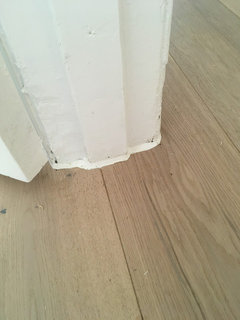
RJ Flooring Specialists
4 years ago<?xml version="1.0" encoding="UTF-8"?><md>I'd be careful using a silicon remover on an oiled floor, deffo test it on an off cut first to ensure it doesn't discolour or effect it.
also, if that's fitted of a big expanse, there isnt enough expansion gap for me, should be at least 15mm expansion around the perimeter.
we always remove skirtings and install underneath.
best bet is Scotia nowRJ Flooring Specialists
4 years agoalso, should have been cut underneath the arcatrave , not around it!
Claudia Cooper thanked RJ Flooring Specialists

Reload the page to not see this specific ad anymore
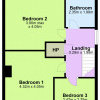



E D